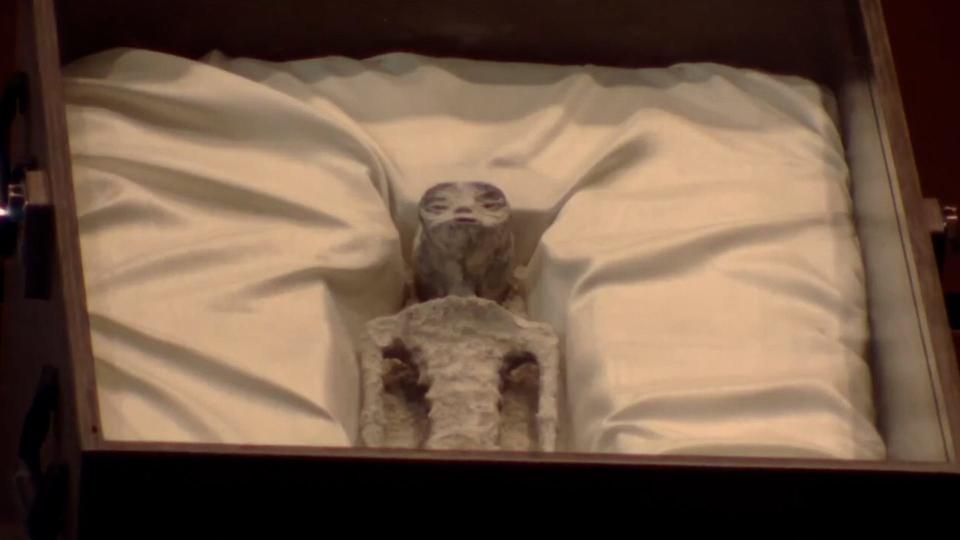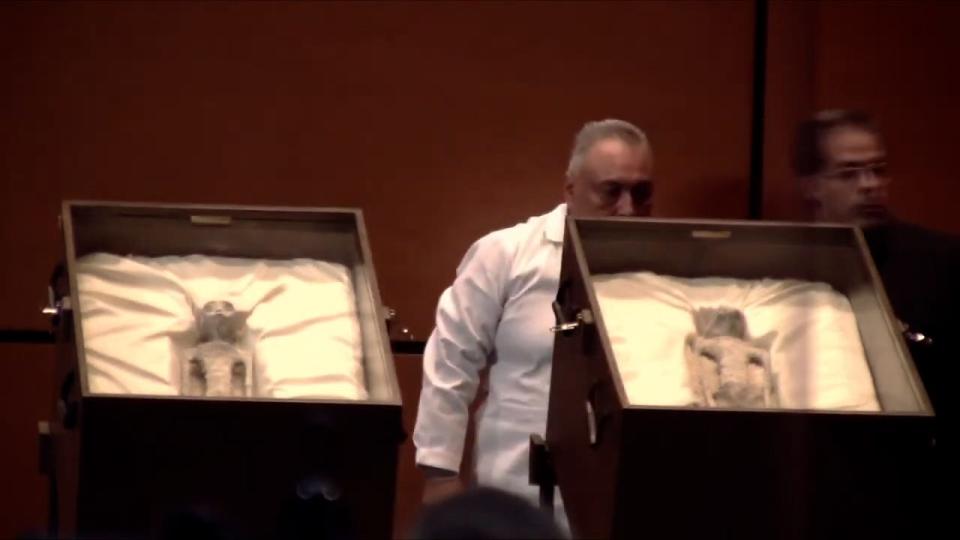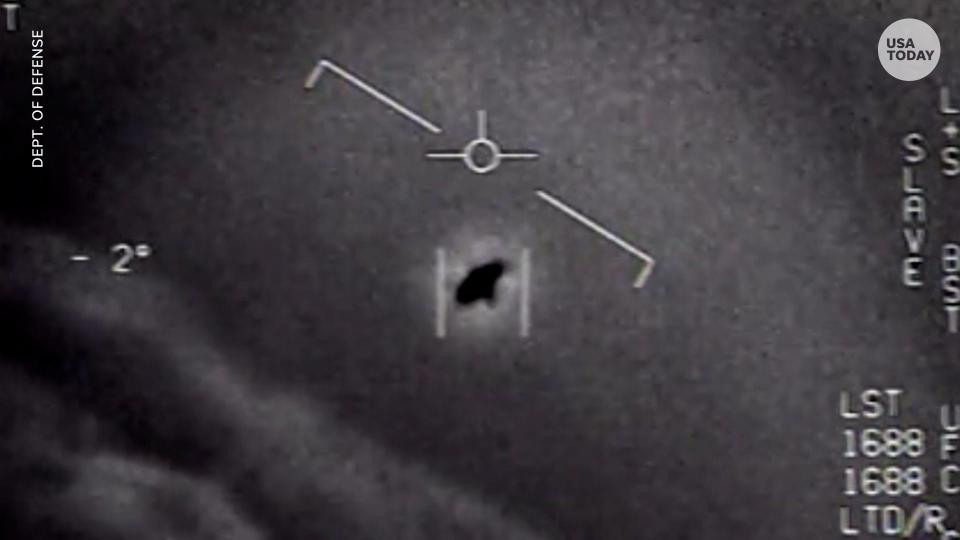Mexican congress shown supposed bodies, X-rays, of 'non-human alien corpses' at UFO hearing
- Oops!Something went wrong.Please try again later.
The creatures, with their tiny bodies, three-fingered hands and elongated heads, looked like something right out of a Hollywood alien invasion blockbuster movie.
But if UFO researcher Jaime Maussan is to be believed, the remains he presented to Mexican lawmakers are the real thing.
Some of Maussan's prior claims have proven to be false but earlier this week, the famed journalist and self-proclaimed UFO expert appeared before Mexican lawmakers, where he presented the remains of what he claimed were two ancient "non-human" alien corpses. The bodies, he testified, were retrieved in 2017 from Cusco, Peru before radiocarbon dating revealed them to be up to 1,800 years old.

Maussan's wild claims, which he presented without third-party evidence, came during a Tuesday congressional hearing in Mexico about UFOs, now referred to by the U.S. government as UAP, short for unidentified anomalous (or aerial) phenomena.
"This is the first time (extraterrestrial life) is presented in such a form and I think there is a clear demonstration that we are dealing with non-human specimens that are not related to any other species in our world," Maussan testified in Spanish.
AUDIENCIA PÚBLICA EN EL CONGRESO DE MÉXICO PARA REGULAR EL FENÓMENO ANÓMALO NO IDENTIFICADO [UAP] 🇲🇽 📷📷📷🇯🇵🇱🇧🇳🇱
La conexión nuclear con #UAP y la seguridad aérea ante #UAP con los Testimonios de Ryan Graves y Robert Salas de primera mano a nivel mundial. pic.twitter.com/m6yW9ptpNR— Jaime Maussan (@jaimemaussan1) September 12, 2023
No longer conspiracy theories? How UFOs became mainstream in America
Supposed alien bodies found to have 'unknown' DNA
The small mummified specimens that Maussan alleges are extraterrestrials were brought out in two glass display cases for lawmakers to observe.
The hearing was to debate language on UAP in the Aerial Space Protection Law. If the language is approved, Mexico would become the first nation to formally acknowledge the presence of alien life ever existing on Earth, the Reuters news agency said, citing local media.
Maussan said that the specimens were found fossilized in mines in Cusco, Peru, in a layer of diatomaceous earth, or ancient phytoplankton algae. The National Autonomous University of Mexico conducted tests on them, which Maussan claimed revealed that more than 30% of the specimens’ DNA was "unknown," indicating that they are "not part of our terrestrial evolution," he said.
X-rays of the specimens were also presented during the hearing, which experts testifying under oath claimed showed that one specimen had what appeared to be eggs or ovaries, while the other had implants made of rare metals, such as Osmium.

NASA UFO report: How NASA hopes to shift UAP talks 'from sensationalism to science'
'A promising step:' NASA says planet 8.6 times bigger than Earth could support life
Jaime Maussan has promoted hoaxes before
Maussan is an investigative journalist who has been researching extraterrestrial phenomenon for decades.
But if Maussan's latest claims — which scientists are already disputing — prove to be false, it wouldn't be the first time.
The UFO researcher, who appears regularly in Mexican media to present his purported findings, has previously been associated with claims of discoveries that have later been debunked.

In 2015, Maussan unveiled the existence of what was alleged to be an alien body unearthed in Nazca, Peru. Later, though, that "alien" discovery was debunked, and the mummified corpse was shown to be that of a human child with a head deformity, according to fact-checking website snopes.com.
In fact, such elongated skulls have often been explained by anthropologists as the result of an ancient practice of artificial cranial deformation. As a part of what could be an ancient religious ritual, young children had their heads bound in cloth, rope and even wooden boards, according to snopes.com.
Earlier this year, Maussan also claimed that a photo of a supposed UFO hovering over the FC Juárez soccer stadium shows "a ship of nonhuman origin."
"I share that the case was analyzed with AI equipment, and everything indicates that we are facing an unidentified anomalous phenomenon 'UAP', (Kyiv) scientists call these ships 'Ghost' for being dark objects," Maussan said in a tweet.
Hunt for extraterrestrial life: Metallic spheres found on Pacific floor are interstellar in origin, Harvard professor finds
Hearing in Mexico follows one in Congress
Mexico's hearing on UAP comes about two months after the United States held a congressional hearing of its own to learn more about the phenomenon.
Former Navy pilot Ryan Graves, who was among three former military members to testify at the July hearing, also appeared Tuesday to speak to Mexican lawmakers. Graves, now the executive director of Americans for Safe Aerospace, has long been outspoken about the dangers military pilots have faced in U.S. airspace during reported encounters with mysterious objects flying in ways that appear to be beyond the capabilities of known human technology.
Former U.S. intelligence official David Grusch also testified in July before a House Oversight subcommittee about his apparent knowledge of a secretive Pentagon program to retrieve and study down spaceships.
Grusch, who was a member of the National Reconnaissance Office, the agency that operates U.S. spy satellites, also accused the government of hiding the program from Congress and misappropriating funds to operate it.

The legal constraints of discussing classified information prevented Grusch from presenting hard evidence of such a program, which the Pentagon has repeatedly denied exists. But in a bipartisan effort, members of Congress have vowed to seek more information about what the military and federal government knows about UFOs.
In a bid for transparency, the Pentagon's relatively new office to investigate UFOs revealed on Sept. 1 a new website where the public can access declassified information about reported sightings.
The All-domain Anomaly Resolution Office (AARO) was launched after the Office of the Director of National Intelligence identified 144 military UAP encounters since 2004 in a preliminary assessment released in June 2021. That figured jumped this year to more than 500 military UAP reports, many of which cannot be explained as natural occurrences such as unmanned aircrafts or weather balloons.
Eric Lagatta covers breaking and trending news for USA TODAY. Reach him at elagatta@gannett.com.
This article originally appeared on USA TODAY: Were the 'alien' corpses shown to Mexican lawmakers real? What we know:

